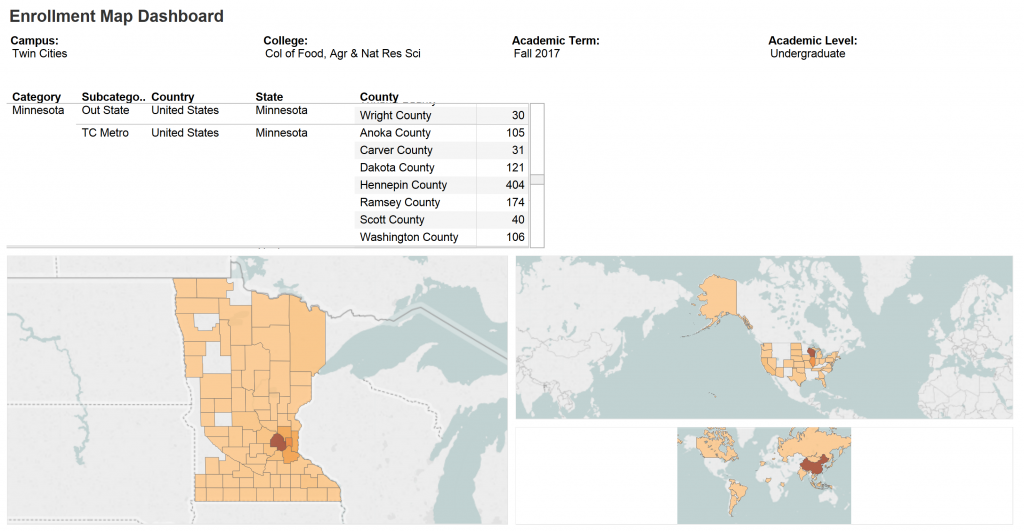As CFANS enrollment becomes more urban, farm values still apply
University of Minnesota student Claire Lentsch grew up on a flat, South Dakota landscape with few trees to buffer the winter storms that could brutalize the state. One winter, she recalled, winds blew snow over her entire home.
“It literally just looked like a huge mound of snow,” Lentsch said.
Without even waiting for a request, her grandpa drove to the Lentsch house and spent a few hours digging out the family. Growing up, that was the way it was, she said: strong family ties, hard work and integrity.
Lentsch was the kind of student who was routinely attracted to the university’s College of Food, Agriculture and Natural Sciences 20 years ago, when rural students accounted for approximately 44 percent of enrollment—many of whom like Lentsch, brought the skills and values of being raised on a farm.
Today, the number of such students has declined to approximately 28 percent—a 16 percent drop, according to data from the university’s Office of Institutional Research. The reasons are complicated, but the main reason is that the number of farmers and farming acreage is declining nationwide.
“We see the number of people living in rural areas decreasing…then that does yield a smaller and smaller pool of students from farms that can come to a university or college like CFANS,” said Michael White, CFANS’s associate dean for academic programs and faculty affairs, adding that the college is actively recruiting students who grew up on farms.
Two years ago, CFANS created the Land-Grant Legacy Scholars Program. The program aims to attract and support students from the Greater Minnesota area. It also awards students a $20,000 scholarship over four years.
“Rural students and especially students from farms are becoming an underrepresented group of students in our college, and so we are actively interested in recruiting them here,” White said.
In many of her classes, Lentsch said she notices two distinct groups in the class: those from farms and those from urban areas. Each group remains to themselves, and Lentsch said this is because these students find it easier to stay around those who seem most like themselves.
In her view, the lack of interaction isn’t born of animosity. If tension exists between the two groups, she said, it is mild.
“Most of it is confusion and lack of communication between groups,” she said. “Coming to the [university] is definitely an intimidating thing, especially for people who haven’t had much exposure with urban life.”
But others say tensions can flourish as the demographics change. Because the number of students from Greater Minnesota enrolled in CFANS is decreasing, the number of metro-area CFANS students has spiked over the past decade. In the fall of 2017, more than 71 percent of CFANS’s undergraduate students were from the metro area.

Jay Bell, a professor in CFAN’s Department of Soil, Water, and Climate, said as a result, the classroom environment has changed in the more than 20 years since he has been teaching classes at the university.
For example, majors with an environment focus, like environmental science, policy and management, are the largest in CFANS. Nationwide, many organizations focused on the environment and sustainability have raised serious questions about the environmental impacts of current agricultural practices. Bell said these debates do surface between agriculture students and environment students.
At the beginning of every semester, Bell asks the students in his introductory soil class how many grew up on family farms. The class has approximately 100 students, and 20 years ago more than half would raise their hands, he said. When Bell asks that question today, no more than 10 hands go up, he said.
“It’s a different environment that students are coming to today than even their parents,” Bell said.
CFANS is interested in attracting students from the Greater Minnesota area because the college wants to educate as many people as it can, not only those who grew up in urban areas, said CFANS Associate Dean Michael White.
Many students grew up in rural areas in school districts with few resources for students, White said. By actively reaching out to these students, CFANS hopes to attract them, educate them and send them back to their home community to educate others in that area, White said.
Looking forward, CFANS aims to combat the declining rural demographic by populating rural areas with highly-educated people, in hopes that they will create vibrant communities that will attract jobs.
As for Lentsch’s plans, she said she wants to travel the Midwest and bridge the gap between the farming and urban communities. She wants to educate those from metro areas about what it is like growing up on a farm and squash any misconceptions. She said there is no specific company that she would like to work for, just that she wants “to connect the dots” between farming and urban communities.
“I look back on my years in a more rural area and I’m very, very glad that I had that experience,” Lentsch said.


